Healthy Meal Plans At Verywell, we know there isn’t one perfect diet for everyone. Eating right means finding what works best for you, considering your whole self. Always talk to a healthcare provider or dietitian before making big changes, especially if you’re not feeling well.
Key Takeaways
- A balanced diet looks different for each person, as nutrition needs vary based on gender, height, weight, activity level, and many more factors.
- Planning a daily menu involves including some protein, fiber, complex carbohydrates, and a little bit of fat in each meal and snack.
- A healthy diet generally includes a combination of vegetables, fruits, whole grains, lean proteins, and healthy fats.
- Consulting with a registered dietitian or healthcare provider can help assess and plan for your specific dietary needs.
- Exploring various healthy meal plan options, including vegetarian and keto-friendly choices, can help you find the right fit for your lifestyle and goals.
Individualized Approach to Healthy Eating
A healthy diet is unique to each person. Your nutritional needs depend on factors like gender, height, weight, and how active you are. When aiming for a healthy and balanced diet, you should consider several important factors.
Consider Personal Factors
Consider what you like to eat and what you can cook when working on a healthy eating plan that fits you. Ask yourself about food preferences, dietary restrictions, and how much time you have for cooking. This can help build a diet plan that works best for you.
Assess Nutrition Goals
First, think about what you want from your diet such as losing weight or improving your health. Knowing these goals is key. It helps you pick the right foods and amounts to meet your goals.
By personalizing your diet, you can make it both healthy and something you enjoy. This sets you on a path for lasting health success.
Principles of Meal Planning
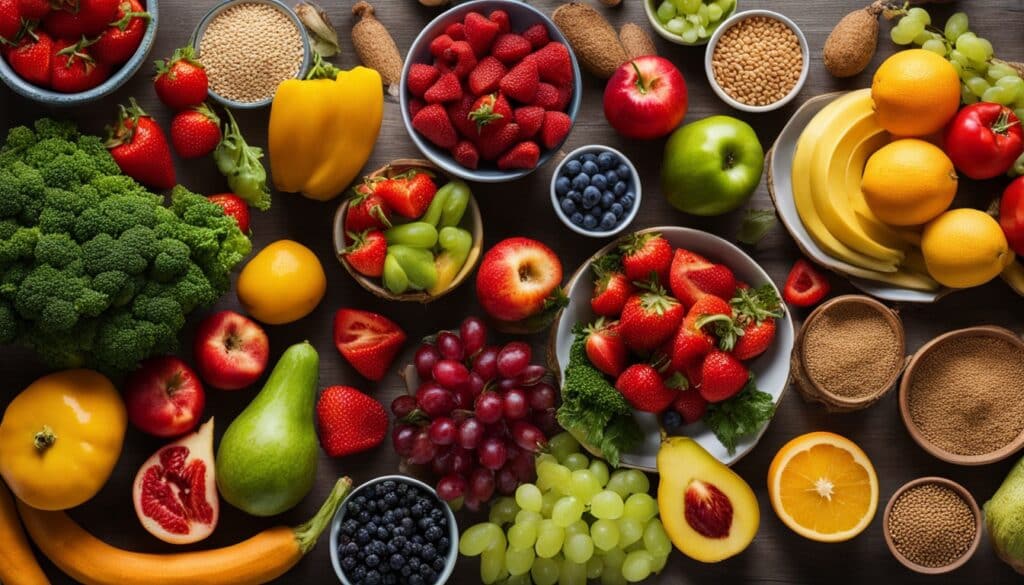
Creating a nutritious meal plan is simple. Follow these easy principles to make meals that enhance your health and fitness.
Basic Meal Constructs
For a balanced meal, mix protein, fiber, complex carbs, and some healthy fats. Keep main meals between 300 to 600 calories and snacks from 100 to 250. Adjust these amounts to fit your own energy needs.
Make a Shopping List
Plan your meals for the week before you shop. Make a detailed shopping list with everything you need, like veggies, lean meats, and whole grains. This keeps you organized and helps avoid buying things you don’t need.
Meal Prep Strategies
Spending time prepping your meals can really make a difference. Use a few hours on the weekend to cook things like veggies, chicken, or quinoa in bulk. It makes putting together healthy meals during the week much simpler.
Components of a Balanced Diet

A balanced diet has several essential parts including:
Vegetables
Vegetables offer crucial nutrients, fiber, and antioxidants. Make sure to eat a mix of colorful veggies like greens, peppers, and carrots.
Fruits
Fruits give us natural sweetness and important vitamins. Enjoy a variety, from fresh to frozen, such as berries and oranges.
Whole Grains
Whole grains like brown rice and whole wheat bread are full of fiber. They also have important nutrients and keep you full.
Lean Proteins
Protein from sources like poultry and fish help grow and repair muscles. It keeps your metabolism and immune system strong too.
Healthy Fats
Avocados and nuts are some sources of healthy fats. These fats benefit your brain, heart, and help absorb vitamins.
Week Meal Plan
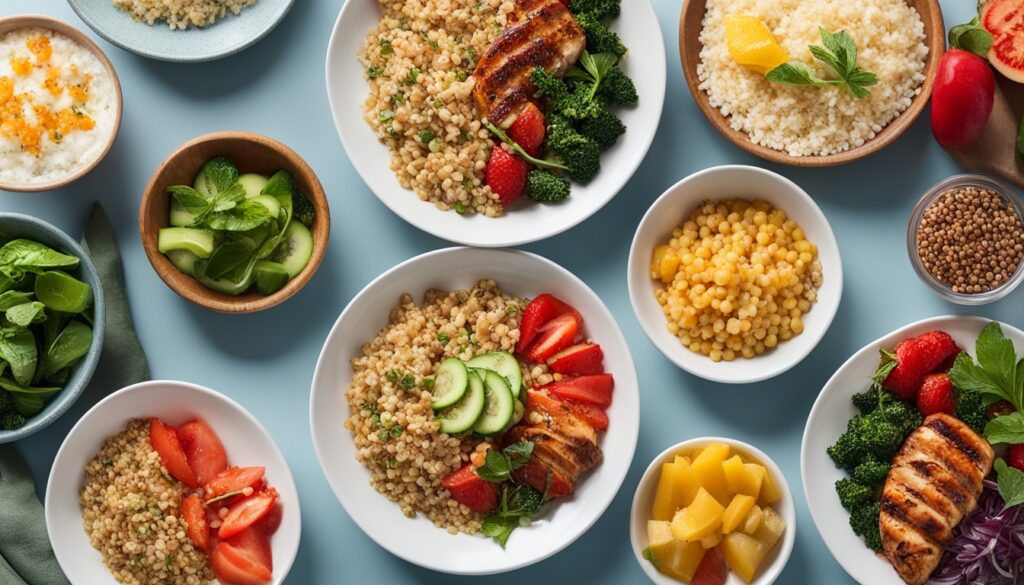
This one-week meal plan is for those who aim for 2,000 to 2,200 calories each day. It is open for someone with no food restrictions. Your daily calorie aim might change. You can adjust this plan to match your needs better. If you want personalized advice, talk to a dietitian or a health professional. They can guide you to plan your meals wisely. Also, a lot of fitness books are available. They help you understand health and nutrition better.
| Day | Breakfast | Lunch | Dinner |
|---|---|---|---|
| Monday | Overnight Oats | Grilled Chicken Salad | Baked Salmon with Roasted Vegetables |
| Tuesday | Avocado Toast | Turkey and Veggie Wrap | Beef Stir-Fry with Brown Rice |
| Wednesday | Scrambled Eggs with Spinach | Lentil and Quinoa Salad | Grilled Chicken Kebabs with Roasted Sweet Potato |
| Thursday | Greek Yogurt with Berries and Granola | Tuna Salad on Whole-Wheat Bread | Baked Cod with Steamed Broccoli and Brown Rice |
| Friday | Oatmeal with Almond Milk and Peanut Butter | Grilled Chicken Caesar Salad | Vegetable Stir-Fry with Tofu and Brown Rice |
| Saturday | Veggie Omelet | Turkey and Cheese Sandwich on Whole-Wheat Bread | Beef and Broccoli Stir-Fry with Quinoa |
| Sunday | Whole-Wheat Pancakes with Berries | Lentil Soup with Whole-Wheat Crackers | Baked Chicken Breast with Roasted Potatoes and Brussels Sprouts |
This plan is just a starting point. Tweak it to fit your calorie, nutrition, and diet needs. A dietitian can really help create a meal plan that’s just right for you. This will support your goals of being healthy and well.
Healthy Breakfast Options
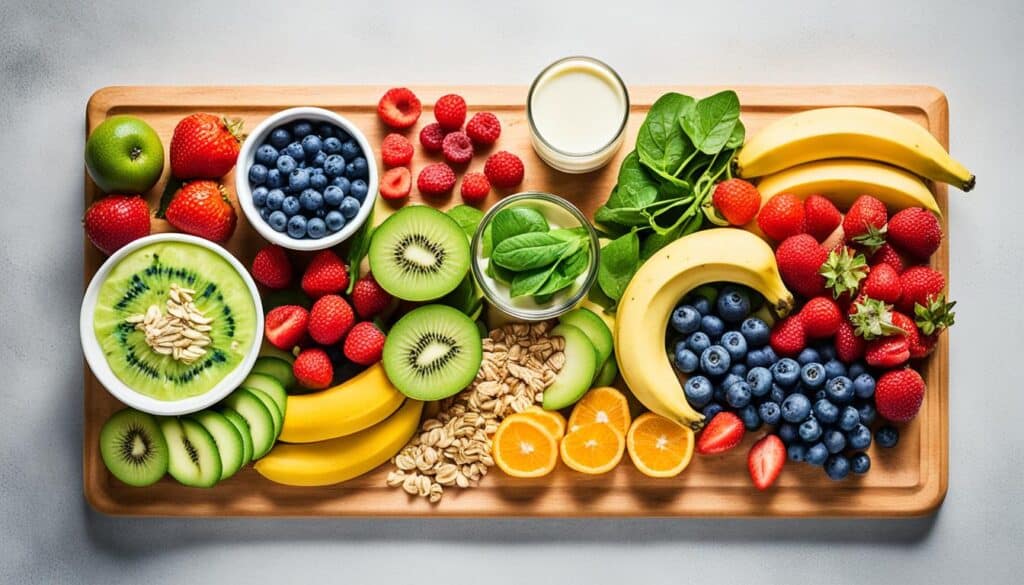
Breakfast is crucial, setting the tone for the day. It’s key to have a nutritious start. Consider these healthy options:
Overnight Oats
Overnight oats are both easy and tasty. Mix a banana, chia seeds, oats, almond milk, and cinnamon. This mix has 431 calories, 12g protein, 73g carbs, and 13g fat. It’s a great option for those busy mornings.
Avocado Toast
Avocado toast is a powerful breakfast. It combines healthy fats and carbohydrates. Add mashed avocado, sea salt, and lemon juice to whole-grain toast for a fulfilling start.
Egg-Based Dishes
Eggs are rich in protein and can be made many ways. Try scrambled eggs with veggies, a frittata full of greens, or a poached egg on a salad.
Nutritious Lunch Ideas
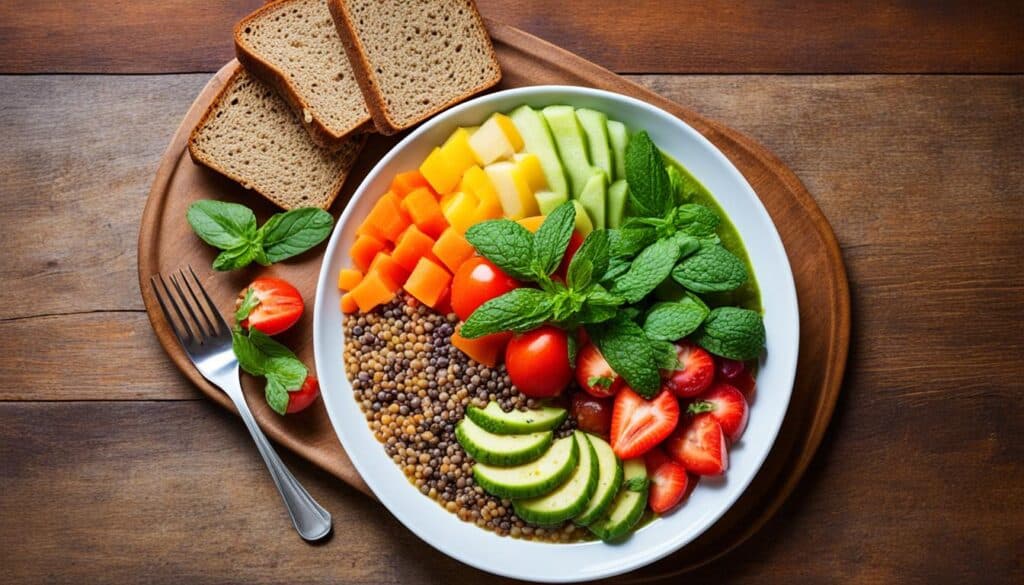
For a healthy and fulfilling lunch, there’s a lot to choose from. You can go for tasty salads, filling bowls, or classic sandwiches. These options will keep you full and focused all afternoon long.
Salads and Bowls
A big garden salad is a great start. It has fresh greens, veggies, and a light dressing. Add protein with grilled chicken, chickpeas, or a hard-boiled egg. Or, try a grain bowl. Use quinoa or brown rice, veggies, and proteins like tofu or salmon.
Sandwiches and Wraps
Use whole-grain bread, lettuce wraps, or tortillas for your base. They’re perfect for making healthy sandwiches or wraps. Fill them with turkey, tuna, avocado, and veggies. Add mustard or hummus for a tasty touch.
Soups and Chilis
A warm soup or chili is a comforting option. Aim for soups with lots of veggies and beans or a chili with turkey or beans. Don’t forget to enjoy them with a salad or some whole-grain bread. It makes a nutritious combo meal.
Healthy Meal Plans
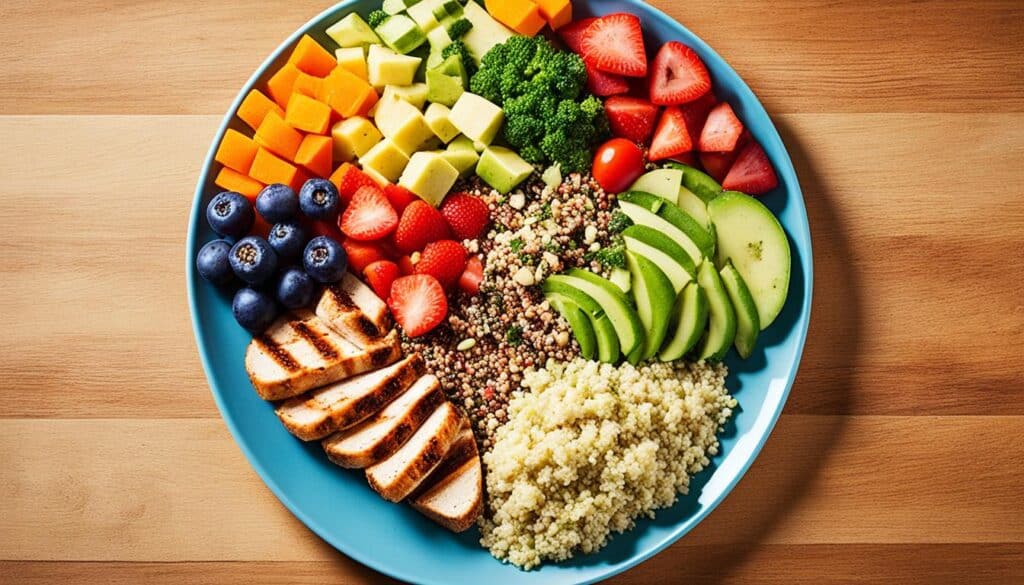
Making a daily menu that’s balanced is key to living healthier. Make sure each meal or snack includes protein, fiber, carbs, and a bit of healthy fats. Snacks should be 100 to 250 calories. Meals should vary between 300 to 600 calories. But, exact amounts change for each person based on things like how hungry you are or how much energy you need.
When you’re putting together your own meal plan, consider what you like to eat, any food restrictions, and your health goals. Here are some tips to help:
- Assess your calorie and macronutrient needs: First, figure out how many calories you need in a day. Then, balance your protein, carbs, and fats. This depends on your age, sex, how active you are, and any health conditions you have.
- Incorporate a variety of nutrient-dense foods: Eat lots of veggies, fruits, whole grains, lean meats, and good fats. Doing this makes sure you’re getting all the vitamins and minerals you need.
- Plan and prepare meals in advance: Take time each week to plan what you’ll eat, make a shopping list, and prepare meals ahead of time. This can keep you eating healthy all week long.
- Experiment with new recipes and flavors: Trying new, healthy recipes can make your meals more fun. It also helps you stick to your healthy eating plan.
A balanced diet looks different for each person. Working with a health expert or dietitian can help you make a meal plan that fits your health goals and lifestyle.
Balanced Dinner Recipes

Making a well-balanced dinner is key for a healthy life. Focus on lean protein, veggies, and whole grains. These offer tasty meals that help reach your wellness goals. Check out some yummy dinner recipes to add to your weekly menu.
Lean Protein Main Dishes
Grilled chicken, baked salmon, or sautéed tofu make great main dishes. They’re full of important amino acids for your muscles. These choices are also low in unhealthy fats and keep your calorie count down. Add colorful veggies and a whole grain to have a full, nutritious meal.
Veggie-Loaded Sides
Eating a variety of veggies at dinner is vital. Roast veggies like Brussels sprouts, sweet potatoes, and bell peppers for taste and color. Sauté spinach or kale in a bit of olive oil for a quick, healthy side with your main dish.
Whole Grain Starches
Include a whole grain like quinoa, brown rice, or whole wheat pasta to your meal. They give your body the energy it needs with complex carbs. Plus, these choices have more fiber, vitamins, and minerals. This makes them better for you than refined options to wrap up your dinner.
Also Read: The Role Of Medical Health Facilities In Community Health And Wellness
Tips for Healthier Eating
To eat well, follow some important dietary advice. The MyPlate model is a great guide for healthy eating.
Use My Healthy Plate
Fill half your plate with fruits and veggies under the MyPlate plan. A quarter should be whole grains, and another quarter lean protein. This mix is key for good health.
Eat Enough Whole Grains
Eating foods like brown rice and whole wheat bread is smart. Make sure half of your grains are whole. This way, you’re getting lots of needed nutrients.
Include Fruits and Veggies
Fruits and veggies are full of what your body needs. They offer vitamins, minerals, and antioxidants. Aim to make your plate colorful with them.
Get Sufficient Protein
Protein is important for your muscles and immune system. Go for lean sources, such as chicken and beans, for your health.
Focus on Calcium
Don’t forget about calcium for strong bones. Dairy is a good source, but so are leafy greens. Also, some fish and plant-based milks have it too.
Choose Healthier Oils
Use good oils like olive and avocado for better heart health. These choices are good for you.
FAQs
Q: What is the importance of having a balanced diet?
A: Having a balanced diet is crucial for maintaining overall health and well-being. It provides your body with essential nutrients, vitamins, and minerals needed to function properly and stay energized.
Q: How can meal plans help with weight loss?
A: Meal plans can help with weight loss by providing structured guidelines on portion size and calorie intake. This can help individuals control their food intake and make healthier choices to support their weight loss goals.
Q: What are the benefits of using a meal delivery service for meal planning?
A: Using a meal delivery service for meal planning can save time and effort in grocery shopping and meal preparation. It provides convenient access to balanced and customized meals based on individual preferences and dietary needs.
Q: How often should I rotate my meal plan featuring different dishes?
A: It is recommended to rotate your meal plan every week to keep your meals interesting and ensure you are receiving a variety of nutrients from different food sources.
Q: Are the meal plans low in calories?
A: Yes, the meal plans are designed to be low in calories to support weight loss and healthy eating habits. Each meal is portion-controlled and aimed at providing a balanced combination of nutrients without excess calories.
Q: Can I customize my meal plan to fit my dietary preferences and needs?
A: Yes, the meal plans are easy to customize based on individual preferences, dietary restrictions, and specific needs. You can choose from a variety of options to create a personalized meal plan that suits your requirements.
Q: How are the meals prepared for delivery?
A: The meals are prepared by experienced chefs using fresh ingredients and following strict quality standards. They are carefully portioned and packaged to maintain freshness during delivery.
Source Links
- https://www.healthline.com/nutrition/easy-healthy-meals
- https://www.verywellfit.com/an-example-of-a-healthy-balanced-meal-plan-2506647
- https://www.healthhub.sg/live-healthy/build_healthy_food_foundation




